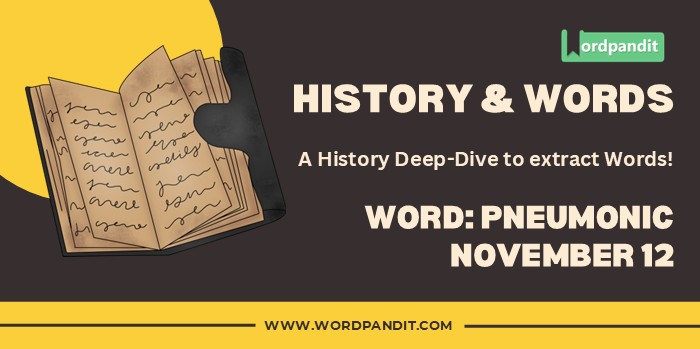History & Words: 'Pneumonic' (November 12)
Welcome to 'History & Words.' 🌟 I'm Prashant, founder of Wordpandit and the Learning Inc. Network. This series combines my passion for language learning with historical context. Each entry explores a word's significance on a specific date, enhancing vocabulary while deepening understanding of history. Join me in this journey of words through time.
📚 Table of Contents
🔍 Word of the Day: Pneumonic
Pronunciation: /nuːˈmɒnɪk/ (noo-MON-ik)
🌍 Introduction
On November 12, 1924, Los Angeles faced the beginning of what would become the last major outbreak of pneumonic plague in the United States. This event marked a crucial moment in American public health history, demonstrating both the devastating potential of infectious diseases and the effectiveness of modern medical responses.
The word "pneumonic" specifically refers to conditions affecting the lungs, and in the context of plague, it describes the most virulent and deadly form of the disease. Unlike bubonic plague, which spreads through flea bites, pneumonic plague transmits directly from person to person through respiratory droplets.
This outbreak served as a wake-up call for public health officials and highlighted the continuing relevance of diseases that many had considered relics of the medieval past. It demonstrated that even in the modern era, ancient diseases could pose serious threats to urban populations.
🌱 Etymology
The term "pneumonic" derives from the Greek "pneumōn" meaning "lung," which itself comes from "pneein," meaning "to breathe." This Greek root appears in many medical terms related to the lungs and breathing, reflecting the ancient Greeks' early understanding of respiratory anatomy and disease.
📖 Key Vocabulary
- 🔑 Quarantine: The isolation of individuals who may have been exposed to an infectious disease
- 🔑 Epidemiology: The study of how diseases spread and how they can be controlled
- 🔑 Vector: An organism that transmits a disease or parasite from one animal or plant to another
- 🔑 Zoonotic: Relating to diseases that can be transmitted from animals to humans
- 🔑 Endemic: Persistently present in a particular region or population
🏛️ Historical Context
Plague has been one of humanity's most feared diseases throughout history. The most infamous outbreak, the Black Death of the 14th century, killed an estimated one-third of Europe's population. The pneumonic form was particularly feared due to its high mortality rate and person-to-person transmission.
By the early 20th century, scientific understanding of plague had advanced significantly. Alexandre Yersin had identified the causative bacterium (Yersinia pestis) in 1894, and the role of rats and fleas in transmission was understood. However, this knowledge didn't prevent occasional outbreaks, particularly in areas where humans lived in close proximity to rodent populations.
The 1924 Los Angeles outbreak occurred during a period of rapid urban expansion in Southern California, when the city's growth was bringing more people into contact with wild rodent populations carrying the disease.
⏳ Timeline
- October 1924: First suspicious cases appear in Los Angeles
- November 12, 1924: First confirmed pneumonic plague case identified
- November 13, 1924: Emergency quarantine measures implemented
- November 14-20, 1924: Door-to-door health inspections conducted
- December 1924: Last case reported
- January 1925: Quarantine lifted after no new cases
- February 1925: City declared plague-free
🌟 The Day's Significance
November 12, 1924, marked the beginning of a focused public health response that would prove crucial in containing what could have become a catastrophic epidemic. The speed and efficiency of the response demonstrated how far public health measures had advanced since previous centuries.
The Los Angeles Health Department, under the leadership of Dr. James Gillespie, implemented immediate containment measures. These included quarantines, contact tracing, and an aggressive rat-control program. The response became a model for future urban disease outbreaks.
This outbreak was significant not only for being the last major pneumonic plague outbreak in the United States but also for demonstrating the effectiveness of modern public health measures in controlling even the most dangerous infectious diseases.
💬 Quote
"The time to stop an epidemic is before it starts." - Dr. James Gillespie, Los Angeles Health Officer, 1924
🔮 Modern Usage and Reflection
Today, "pneumonic" remains an important medical term, particularly in discussions of respiratory diseases and public health. The COVID-19 pandemic has renewed interest in historical disease outbreaks and the public health measures used to control them.
The lessons learned from the 1924 outbreak continue to influence modern epidemic response strategies, particularly the importance of rapid identification, isolation of cases, and comprehensive contact tracing.
🏛️ Legacy
The 1924 Los Angeles plague outbreak left a lasting impact on public health practices in the United States. It led to improved sanitation standards, better disease surveillance systems, and more effective quarantine protocols.
These improvements would prove valuable in addressing future public health challenges, from polio outbreaks to modern pandemic responses. The event also highlighted the importance of maintaining robust public health infrastructure even in times of apparent safety.
🔍 Comparative Analysis
While the 1924 outbreak was viewed primarily as a local crisis at the time, modern perspective sees it as a pivotal moment in American public health history. Today's understanding emphasizes not just the medical response but also the social and environmental factors that contributed to the outbreak, including urbanization and human-wildlife interaction.
💡 Did You Know?
🎓 Conclusion
The pneumonic plague outbreak of 1924 serves as both a warning about the persistent threat of infectious diseases and a testament to the effectiveness of coordinated public health responses. As we continue to face new disease challenges in the 21st century, the lessons learned from this historical event remain remarkably relevant.
📚 Further Reading
- 📘 "The Last Plague: Spanish Influenza and the Politics of Public Health in Los Angeles" by Jennifer Koslow
- 📗 "Epidemics and Society: From the Black Death to the Present" by Frank M. Snowden
- 📙 "Disease and Discovery: A History of the Johns Hopkins School of Hygiene and Public Health" by Elizabeth Fee











